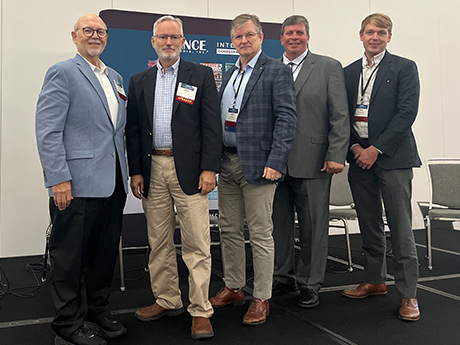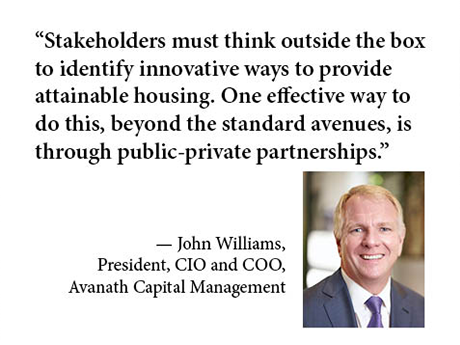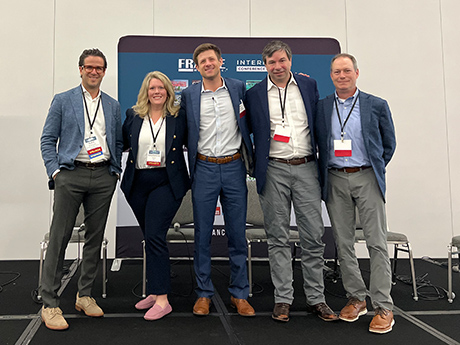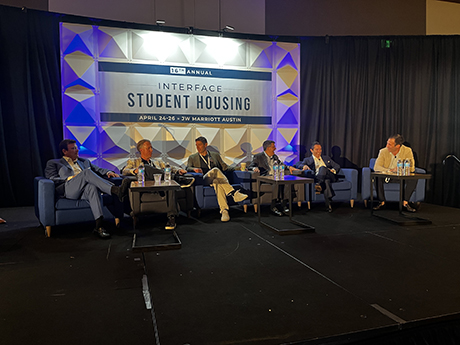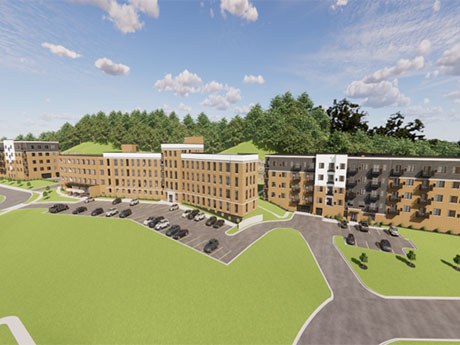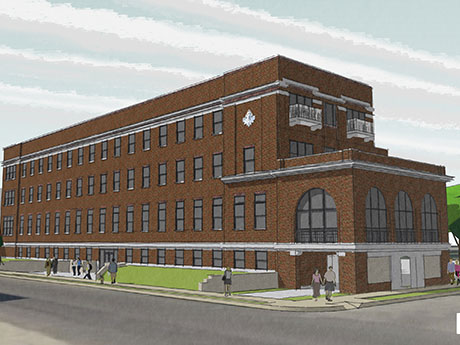ATLANTA — In order to satisfy long-term affordability commitments, builders and designers of affordable housing must be well educated about the sector’s exacting design and construction rules, which are typically driven by the source of a project’s funding. A panel of construction experts speaking at the InterFace Affordable Housing Southeast conference held Thursday, May 9 at Cobb Galleria Centre shared insights about how their industry is meeting these standards today. The inaugural conference hosted by France Media’s InterFace Conference Group and Southeast Multifamily & Affordable Housing Business drew approximately 170 industry professionals. Energy efficiency, teamwork and accessibility were three themes running through the discussion. Accessibility in multifamily construction refers to features that enable people with disabilities or limited mobility to navigate common areas and individual units comfortably and safely. Many of these building features are required by various laws. “Get your consultants, architects and contractors to help you put the deal together,” advised Ross Haynes, chief executive officer of Roswell, Georgia-based Community Construction Group. The company focuses on construction and renovation of affordable housing projects. “That team is there to understand the code requirements that affect the job, including energy programs and accessibility,” added Haynes. Specific energy-efficiency requirements for affordable housing vary. …
Features
Public-Private Partnerships: A Creative Approach to Increasing Affordable Housing Supply
by Jeff Shaw
— By John Williams, president, CIO and COO of Avanath Capital Management — It’s no secret that the dire shortage of affordable housing is an ongoing issue throughout the nation. The National Multifamily Housing Council reported in 2022 that the United States would need to build 4.3 million new apartments by 2035 to meet demand. The report also stated that the nation’s number of affordable housing units declined by 4.7 million from 2015 to 2020. Unfortunately, there is no one-size-fits-all solution to the problem. Both local and federal governments are taking steps to address the lack of supply in the market. President Biden’s 2024 Economic Report to Congress, for instance, prominently featured plans to increase the supply of and access to affordable housing. In the meantime, however, stakeholders must think outside the box to identify innovative ways to provide attainable housing. One effective way to do this, beyond the standard avenues, is through public-private partnerships. Public-private partnerships are a strategy that can benefit a wide range of stakeholders — including investors, developers, institutional owners, operators, property managers, service providers and leaders in nonprofit and government entities. In addition to serving renters with lower incomes and other specialized needs, actively pursuing these partnerships …
AcquisitionsAffordable HousingConference CoverageFeaturesGeorgiaMultifamilySoutheastSoutheast Feature Archive
Volatility Disrupts Investment Sales Activity in Affordable Housing Market, Says InterFace Panel
by John Nelson
ATLANTA — The investment sales market for the affordable housing sector remains muted for one overarching reason: volatility. Cory Sams, executive managing director of GREA (Global Real Estate Advisors), said that a lack of certainty, especially in the capital markets, is giving buyers and sellers of affordable housing properties pause. “The worst thing for a deal is [interest rates] constantly moving around,” she said. “When they were running up and down, every deal fell apart.” Doug Childers, senior managing director of JLL, estimated that affordable housing transaction volume fell 40 percent in 2023 compared with the prior year. For context, multifamily investment sales overall declined by 61 percent year-over-year in 2023, according to MSCI Real Assets (formerly Real Capital Analytics). Childers and Sams made their comments during the investment sales panel of Interface Affordable Housing Southeast, an information and networking conference held at the Cobb Galleria Centre in Atlanta on Thursday, May 9. Interface Conference Group and Southeast Multifamily & Affordable Housing Business hosted the event, which drew approximately 170 industry professionals from across the region. Brian Flanagan, regional director of RBC Community Investments, moderated the investment sales panel. Fittingly, Flanagan kicked off the investment sales discussion by asking the …
Sports and entertainment destinations offer several benefits to retail properties — they boost foot traffic, encourage consumers to linger, complement traditional retail and provide opportunities for refilling vacancies. Pickleball, gaming and music venues are some of the most prolific concepts in today’s experiential marketplace. “These users draw consumers into a development,” says Tim Katt, managing director of Transwestern Real Estate’s sports and entertainment advisory group. “Their ability to take up large, often dormant spaces and activate them is undeniable.” Industry professionals emphasize that sports and entertainment tenants play a complementary role for traditional retailers. Steven Mueller, senior project manager with St. Louis-based HDA Architects, says that mixing entertainment concepts like pickleball with attached or adjacent restaurants is an “especially hot combination.” The idea is to entice guests to spend more time and money in a single location. “Entertainment is complementary to retail in the sense that you get cross-pollination between tenants,” says Beau Arnason, executive vice president of asset performance at Columbus, Ohio-based Steiner + Associates. “You may come to a lifestyle center for an entertainment experience, but stop for food, drinks and shopping along the way.” Properly curating entertainment uses within retail and food-and-beverage spaces provides the opportunity to …
By Gib Laite, Esq. of Williams Mullen Multifamily investors are accustomed to paying property taxes based on an assessor’s opinion of their asset’s income-based market value. But for the growing number of developers and investors assembling communities of single-family homes and townhomes for rent, tax assessment is more complex and potentially troublesome. The difficulty for these taxpayers is that most assessors shun the income approach to valuing single-family rental properties. In the following paragraphs, we examine the roots of this common assessor stance, and explore strategies that may help taxpayers argue for a more predictable, apartment-like treatment for their single-family rental communities. Similar, but different Multifamily construction has delivered a tremendous volume of apartment properties over the past decade. Once stabilized, these assets have been relatively simple to value by relying on market rents, occupancy, expenses, and cap rates. On the heels of this apartment construction, the nation is seeing a proliferation of investor-backed, single-family construction and acquisitions of large blocks of homes and townhouses for use as rental properties. This may take the form of constructing a multitude of homes or townhomes in a single development. Alternatively, it may involve the acquisition of many existing homes or townhomes in …
AUSTIN, TEXAS — It’s no secret that today’s commercial real estate market can be challenging, whether you’re looking to break ground on a new project or close a transaction. But there’s plenty to be optimistic about in the student housing sector moving forward, according to Peter Katz, executive managing director of Institutional Property Advisors. Katz moderated this year’s “Power Panel,” which kicked off the first full day of the 16th annual InterFace Student Housing conference, held at the JW Marriott in Austin. The panel brought together a consortium of high-level executives to provide their thoughts on the current dynamics in the sector and their outlook for the year ahead. “I always feel the energy and the excitement in the student housing sector,” began Katz. “And while we feel a sense of tempered exuberance this year, the investment community is still extremely enthusiastic. Consumer strength is coming in hotter than expected and inflationary readings are pushing out the timing of proposed interest rate cuts from The Fed.” Two years into the cycle of tightening from The Fed, investors are recognizing that the price adjustments that have already occurred have now become an acquisition opportunity, Katz continued. “And while there’s still pain …
AcquisitionsContent PartnerDevelopmentFeaturesIndustrialLeasing ActivityLee & AssociatesLoansMidwestMultifamilyNortheastOfficeRetailSoutheastTexasWestern
Lee & Associates Report: Industrial, Office Sectors Face Challenges as Retail, Multifamily Show Positive Trends
Economic headwinds such as elevated interest rates and persistent inflation led to mixed outcomes in the first quarter for industrial, office, retail and multifamily sectors, with market observers anticipating a contracting economy, as outlined by Lee & Associates’ 2024 Q1 North America Market Report. On the industrial front, market pressures — including interest rates and supply chain challenges — led to higher vacancy in the United States in the first quarter of the year. U.S. office space experienced its fifth consecutive year of contraction, as office worker attendance stagnated. Additional challenges, in the form of loans maturing in a high-rate environment, signal further challenges in the near future for the office landscape. Continued merchant demand, reduced closures and bankruptcies and limited supply converged to create a feeding frenzy for retail space, with vacancies at historic lows. And finally, geographically based factors drove multifamily markets, many of which (especially in the Midwest and Northeast) experienced a rebound in apartment demand fueled by rising consumer sentiment and moderating inflation, despite supply outpacing demand. Lee & Associates has made their full, first-quarter report available here (with breakdowns of cap rates by city, vacancy rates, market rents, inventory square footage and more). The summaries from each sector …
Cannabis Dispensary Development Requires Specialized Site Selection, Design for Success
by John Nelson
By Virginia Maggiore of RDC Although the roadmap to opening a dispensary presents unique challenges inherent to the cannabis industry, the process shares many parallels with traditional retail projects. From selecting the optimal site, designing the brand and interior and implementing the build-out plan, the similarities are evident. However, a pivotal differentiator lies in the need to assemble a team that has experience with cannabis laws, sites, operations and build-outs. The collective expertise comprised by seasoned architects, designers and general contractors is instrumental in navigating the complexities of the cannabis industry, avoiding unnecessary expenses and delays, while ensuring a successful store opening. Selecting the Optimal Site The first step in the process to opening a dispensary involves choosing the optimal property for the storefront. While some entrepreneurs opt for ground-up construction, the majority leverage existing vacant spaces, repurposing them into cannabis dispensaries. Operators that are refurbishing an existing property for retail will want to select a site that boasts a vanilla shell or blank canvas for the new store to build upon. Choosing properties that already contain many of the costly elements like utilities and bathrooms can greatly minimize construction expenses. This allows operators to save their budget for a …
Property Assessed Clean Energy (PACE) is a financing tool that provides long-term, low-cost construction financing for new and existing buildings. Some of the eligible improvements include energy efficiency, water efficiency, renewable energy and resiliency measures such as seismic and stormwater measures. For commercial real estate properties, the acronym is listed as C-PACE. Rafi Golberstein, CEO of Minneapolis-based PACE Loan Group, says there are many reasons why developers like PACE financing today, but the most important is the cheaper cost of capital. REBusinessOnline spoke with Golberstein to learn more about the financing tool and its benefits. REBusinessOnline: What is driving momentum for PACE financing? Rafi Golberstein: PACE is effectively solving a hole in the capital stack. In today’s market when banks and mortgage lenders have tightened up significantly, typically lending less and providing less leverage, that creates a pretty large equity check requirement that is significantly larger than it was two years ago. PACE is coming in to help alleviate some of that pressure to allow these projects to still move forward. In some cases, we’re actually cheaper than the banks. For the developer, it makes a lot of sense to use PACE. There are other structural reasons as well. Bank …
With office occupancy still well below pre-pandemic levels due to the prevalence of the hybrid work model and companies downsizing their space needs, property owners are resorting to creative solutions for vacant or underutilized buildings. The conversion of office properties into new uses such as multifamily or hospitality is one approach. While these adaptive reuse projects are not for the faint of heart, they are an important way to avoid demolition. Construction debris from demolition projects contributes to the building industry’s huge carbon footprint, states Alan Barker, principal and residential market leader at Chicago-based architecture firm Lamar Johnson Collaborative (LJC). When considering an office conversion project, the first step is to make sure that the building’s structural integrity can safely accommodate renovations. Beyond that, office buildings that are a good fit for adaptive reuse typically have flexible floor plans, access to light and ventilation, existing utilities that can handle changes in capacity, and a location that offers proximity to amenities, transportation and parking, according to Barker. Recently, LJC created an adaptive reuse scorecard to help developers and building owners assess a property’s potential for a conversion project. The scorecard is comprised of seven categories: development potential; building form; building systems; …


